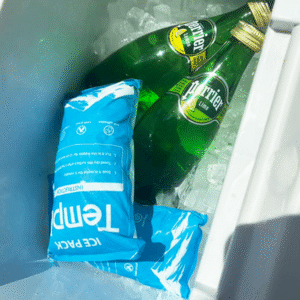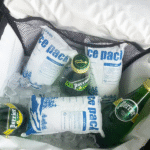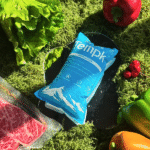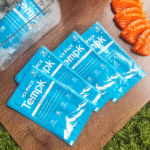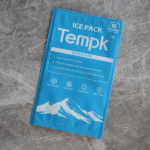Cómo etiquetar las paquetes de hielo seco de acuerdo con las regulaciones de IATA en 2025
Al enviar hielo seco, El etiquetado adecuado no se trata sólo de cumplir con los requisitos reglamentarios.; garantiza la seguridad durante el tránsito. Como material peligroso, hielo seco (dióxido de carbono sólido, Y 1845) está sujeto a estrictas regulaciones bajo la Asociación Internacional de Transporte Aéreo (IATA). En esta guía, te guiaremos a través cómo etiquetar paquetes de hielo seco según el último informe de la IATA 2025 estándares, Proporcionar información esencial sobre los símbolos., documentación, embalaje, y errores comunes a evitar.
-
¿Cuáles son las pautas de la IATA para etiquetar paquetes de hielo seco??
-
¿Por qué es esencial un etiquetado preciso para un transporte seguro de hielo seco??
-
¿Cómo se puede garantizar que los paquetes de hielo seco cumplan con las regulaciones de la IATA??
-
¿Qué sanciones existen por un etiquetado inadecuado??
-
¿Cuáles son las últimas actualizaciones para el envío de hielo seco en 2025?
¿Cuáles son las pautas de la IATA para etiquetar paquetes de hielo seco??
Regulaciones sobre mercancías peligrosas de la IATA (Dgr) especificar directrices claras para el etiquetado de paquetes de hielo seco. El hielo seco se clasifica como un material peligroso (UN1845) y debe manipularse con cuidado para evitar riesgos potenciales como asfixia., congelación, u otros peligros causados por su sublimación en gas dióxido de carbono. Aquí hay un desglose detallado de los requisitos de etiquetado..
Requisitos clave de etiquetado para hielo seco:
-
Número de la ONU: Marque el paquete con “Y 1845” para identificar que contiene hielo seco.
-
Clase 9 Etiqueta de materiales peligrosos: El hielo seco entra en la clase 9, y se debe utilizar una etiqueta de diamante específica para materiales peligrosos..
-
Peso del hielo seco: Indique en la etiqueta el peso neto del hielo seco en kilogramos..
-
Nombre de envío adecuado: El paquete debe mostrar el nombre de envío adecuado.: “Hielo seco” o “Dióxido de carbono, Sólido.”
-
Sólo aviones de carga (Si corresponde): Si el hielo seco excede 5.5 kilos, marcar el paquete con “SOLO AERONAVES DE CARGA” para evitar que sea transportado en la cabina de pasajeros.
Instrucciones generales de embalaje:
El hielo seco debe empaquetarse de manera que permita la liberación segura de dióxido de carbono durante el tránsito.. El embalaje debe evitar la acumulación peligrosa de presión y al mismo tiempo garantizar la seguridad de los manipuladores y pasajeros.. También debe ser resistente a la humedad o a cualquier material que pueda provocar una reacción peligrosa..
¿Por qué es importante el etiquetado correcto para el transporte aéreo con hielo seco??
Etiquetar correctamente el hielo seco es esencial no solo para el cumplimiento normativo sino también para la seguridad.. El hielo seco se sublima convirtiéndose en dióxido de carbono, que puede desplazar el oxígeno en espacios confinados, plantear graves riesgos para la salud del personal y los pasajeros si no se manipula correctamente. Un etiquetado incorrecto puede provocar un mal manejo, retrasos, y riesgos de seguridad.
Beneficios del etiquetado correcto:
-
Seguridad: Un etiquetado preciso garantiza una manipulación adecuada, Reducir los riesgos asociados con la naturaleza peligrosa del hielo seco..
-
Cumplimiento: Cumplir con las directrices de la IATA ayuda a evitar multas y retrasos causados por un etiquetado inadecuado.
-
Eficiencia: Las etiquetas correctas aceleran el proceso de envío y despacho, garantizando un tránsito fluido para sus paquetes.
Riesgos de un etiquetado inadecuado:
-
Penalizaciones: El incumplimiento de las normas de etiquetado puede dar lugar a multas, retrasos, e incluso la confiscación de bienes.
-
Peligros de seguridad: Un etiquetado incorrecto puede provocar accidentes como la asfixia, congelación, o incluso explosiones en casos extremos.
-
Retrasos en el envío: Los paquetes mal etiquetados pueden causar retrasos debido a requisitos de reinspección o reetiquetado.
Cómo garantizar que los paquetes de hielo seco cumplan con las regulaciones de la IATA?
Para garantizar el pleno cumplimiento de la normativa IATA, sigue estos pasos esenciales:
1. Revise las regulaciones sobre mercancías peligrosas de la IATA (Dgr)
Familiarícese con las regulaciones sobre mercancías peligrosas de la IATA, especialmente las secciones relevantes para el envío de hielo seco y materiales peligrosos..
2. Etiquetado adecuado
Asegúrese de que el número ONU (Y 1845), Clase 9 etiqueta de material peligroso, y el peso del hielo seco están claramente marcados en el paquete.
3. Utilice contenedores aprobados
Utilice únicamente contenedores aprobados por la IATA y diseñados para hielo seco.. Estos contenedores permiten la liberación adecuada de gas dióxido de carbono al tiempo que garantizan la seguridad del contenido..
4. Verificar el peso del paquete
Asegúrese de que el peso del hielo seco esté dentro de los límites permitidos.. Para aviones de pasajeros, el límite es 2.5 kilos, mientras que los aviones de carga pueden acomodar hasta 5.5 kg por paquete.
5. Restricciones de aviones de carga
Si su envío de hielo seco excede el 5.5 límite de kg, asegúrese de que el paquete esté claramente etiquetado como "SOLO AERONAVES DE CARGA".
Símbolos clave de etiquetado y requisitos para paquetes de hielo seco
Los paquetes de hielo seco deben presentar varias marcas obligatorias para cumplir con las regulaciones de la IATA:
-
Y 1845 Símbolo: Indica que el paquete contiene hielo seco..
-
Ejemplo: Y 1845
-
Hielo seco
-
-
Clase 9 Etiqueta de materiales peligrosos: Una etiqueta en forma de diamante que indica materiales peligrosos diversos..
-
Sólo aviones de carga (Si corresponde): Para envíos de hielo seco que excedan 5.5 kilos, Esta marca restringe el transporte a aviones de carga..
-
Peso del hielo seco: El peso exacto del hielo seco en kilogramos debe estar marcado en el paquete..
| Componente de etiqueta | Descripción | Importancia |
|---|---|---|
| Número de la ONU (Y 1845) | Identifica el material peligroso. (hielo seco). | Esencial para la identificación y la seguridad.. |
| Clase 9 Etiqueta | Etiqueta en forma de rombo para materiales peligrosos diversos. | Requerido para todos los envíos de hielo seco. |
| Sólo aviones de carga | Indica que el envío no se puede transportar en cabinas de pasajeros.. | Garantiza el cumplimiento de las restricciones en el transporte aéreo. |
| Peso del hielo seco | Peso exacto en kilogramos.. | Crítico para la seguridad y el cumplimiento. |
Últimas tendencias en transporte y etiquetado de hielo seco (2025)
A partir de 2025, Varios avances están influyendo en el transporte y el etiquetado del hielo seco.. La atención se centra en la sostenibilidad, digitalización, y protocolos de seguridad mejorados. Estas tendencias tienen como objetivo mejorar la eficiencia general y la seguridad del transporte de productos sensibles a la temperatura., como productos farmacéuticos y alimentos perecederos.
Tendencias clave:
-
Sostenibilidad: El mayor uso de materiales de embalaje ecológicos y contenedores de hielo seco reutilizables se está convirtiendo en una prioridad para reducir el impacto ambiental..
-
Etiquetado inteligente: La integración de códigos RFID y QR para seguimiento en tiempo real y control de temperatura está creciendo, permitiendo a los transportistas garantizar la integridad de sus envíos de hielo seco.
-
Protocolos de manejo mejorados: Las aerolíneas y las empresas de logística están adoptando procedimientos de manipulación más rigurosos para mejorar la seguridad y la eficiencia del transporte de materiales peligrosos..
Preguntas frecuentes
Q1: ¿Cuáles son las sanciones por etiquetado inadecuado del hielo seco??
No etiquetar correctamente el hielo seco puede dar lugar a multas, retrasos, y mercancías rechazadas. Es crucial cumplir con las regulaciones de la IATA para evitar este tipo de sanciones..
Q2: ¿Cuál es el peso máximo para el hielo seco en los aviones de pasajeros??
Los aviones de pasajeros sólo pueden transportar hasta 2.5 kg de hielo seco por paquete. Si el peso excede este, El hielo seco debe enviarse en aviones de carga..
Q3: ¿Necesito una Declaración del Transportista para Mercancías Peligrosas??
Solo se requiere una Declaración del Remitente si se utiliza hielo seco con otros materiales peligrosos.. Si se utiliza hielo seco únicamente como refrigerante, no requiere esta declaración.
Conclusión e ideas prácticas
Etiquetar correctamente los envíos de hielo seco según la IATA 2025 Las regulaciones garantizan la seguridad., eficiente, y transporte conforme. Siguiendo estas pautas actualizadas, evitarás retrasos, sanciones, y riesgos de seguridad, al tiempo que mejora la eficiencia general de su logística de cadena de frío..
Pasos procesables:
-
Familiarícese con el Reglamento de mercancías peligrosas de la IATA para hielo seco.
-
Asegúrese de que sus paquetes de hielo seco estén correctamente etiquetados con el número ONU, símbolos de peligro, peso, y nombre de envío adecuado.
-
Revise y cumpla periódicamente con las últimas tendencias y regulaciones para mantenerse a la vanguardia de los estándares de la industria..
Acerca de Tempk
TEMPK es un líder en la logística de la cadena de frío, ofreciendo soluciones de envasado de hielo seco seguras y confiables que cumplen con las regulaciones IATA. Nuestros productos garantizan que sus productos, ya sean productos farmacéuticos o alimentos perecederos, se transportan de forma segura y eficiente.
Contáctenos hoy para descubrir cómo nuestras soluciones de hielo seco pueden ayudarlo a optimizar sus operaciones de envío..






